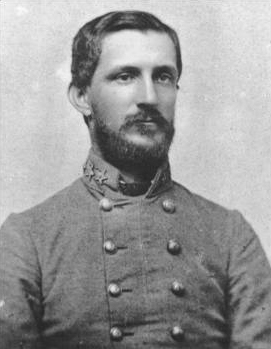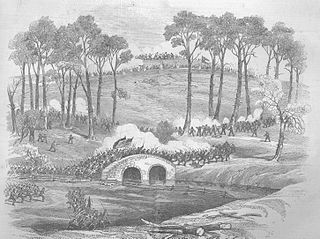
United States Colored Troops (USCT) were Union Army regiments during the American Civil War that primarily comprised African Americans, with soldiers from other ethnic groups also serving in USCT units. Established in response to a demand for more units from Union Army commanders, USCT regiments, which numbered 175 in total by the end of the war in 1865, constituted about one-tenth of the manpower of the army, according to historian Kelly Mezurek, author of For Their Own Cause: The 27th United States Colored Troops. "They served in infantry, artillery, and cavalry." Approximately 20 percent of USCT soldiers were killed in action or died of disease and other causes, a rate about 35 percent higher than that of white Union troops. Numerous USCT soldiers fought with distinction, with 16 receiving the Medal of Honor. The USCT regiments were precursors to the Buffalo Soldier units which fought in the American Indian Wars.

The Battle of New Bern was fought on March 14, 1862, near the city of New Bern, North Carolina, as part of the Burnside Expedition of the American Civil War. The US Army's Coast Division, led by Brigadier General Ambrose Burnside and accompanied by armed vessels from the North Atlantic Blockading Squadron, were opposed by an undermanned and badly trained Confederate force of North Carolina soldiers and militia led by Brigadier General Lawrence O'B. Branch. Although the defenders fought behind breastworks that had been set up before the battle, their line had a weak spot in its center that was exploited by the attacking Federal soldiers. When the center of the line was penetrated, many of the militia broke, forcing a general retreat of the entire Confederate force. General Branch was unable to regain control of his troops until they had retreated to Kinston, more than 30 miles away. New Bern came under Federal control, and remained so for the rest of the war.

USS Southfield was a double-ended, sidewheel steam gunboat of the Union Navy during the American Civil War. She was sunk in action against the Confederate ironclad ram CSS Albemarle during the Battle of Plymouth (1864).

The Battle of Hatteras Inlet Batteries was the first combined operation of the Union Army and Navy in the American Civil War, resulting in Union domination of the strategically important North Carolina Sounds.

The Battle of Valverde, also known as the Battle of Valverde Ford, was fought from February 20 to 21, 1862, near the town of Val Verde at a ford of the Rio Grande in Union-held New Mexico Territory, in what is today the state of New Mexico. It is considered a major Confederate success in the New Mexico Campaign of the American Civil War, despite the invading force abandoning the field. The belligerents were Confederate cavalry from Texas and several companies of Arizona militia versus U.S. Army regulars and Union volunteers from northern New Mexico Territory and the Colorado Territory.

Robert Frederick Hoke was a Confederate major general during the American Civil War. He was present at one of the earliest battles, the Battle of Big Bethel, where he was commended for coolness and judgment. Wounded at Chancellorsville, he recovered in time for the defense of Petersburg and Richmond. His brigade distinguished itself at Cold Harbor, acknowledged by Grant as his most costly defeat. Hoke was later a businessman and railroad executive.

Florida participated in the American Civil War as a member of the Confederate States of America. It had been admitted to the United States as a slave state in 1845. In January 1861, Florida became the third Southern state to secede from the Union after the November 1860 presidential election victory of Abraham Lincoln. It was one of the initial seven slave states which formed the Confederacy on February 8, 1861, in advance of the American Civil War.
Galvanized Yankees was a term from the American Civil War denoting former Confederate prisoners of war who swore allegiance to the United States and joined the Union Army. Approximately 5,600 former Confederate soldiers enlisted in the United States Volunteers, organized into six regiments of infantry between January 1864 and November 1866. Of those, more than 250 had begun their service as Union soldiers, were captured in battle, then enlisted in prison to join a regiment of the Confederate States Army. They surrendered to Union forces in December 1864 and were held by the United States as deserters, but were saved from prosecution by being enlisted in the 5th and 6th U.S. Volunteers. An additional 800 former Confederates served in volunteer regiments raised by the states, forming ten companies. Four of those companies saw combat in the Western Theater against the Confederate Army, two served on the western frontier, and one became an independent company of U.S. Volunteers, serving in Minnesota.

The 20th Indiana Volunteer Infantry Regiment was an infantry regiment that served in the Union Army during the American Civil War. The Regiment was officially raised on July 22, 1861, by William L. Brown, the first Colonel of the Regiment, in response to President Lincoln's call for volunteers. At the time of muster, the regiment had 9 fighting companies lettered A-K along with a staff company for a total of 10 companies, roughly 1000 men. The 20th Indiana saw engagements in most of the major battles of the American Civil War, including the action between the first ironclads at Hampton Roads, the Battle of Fredericksburg, the Battle of Gettysburg, and the Siege of Petersburg. The Regiment was part of the 1st Brigade, 3rd Division, III Corps for the duration of the war.
Burnside's North Carolina Expedition was a series of engagements fought along the North Carolina Coast between February and June 1862. The expedition was part of Winfield Scott's overall Anaconda Plan, which aimed at closing blockade-running ports inside the Outer Banks. The amphibious operation was carried out primarily by New England and North Carolina troops under Brig. Gen. Ambrose E. Burnside and assisted by the North Atlantic Blockading Squadron under Captain Louis M. Goldsborough.

The 51st Regiment Massachusetts Volunteer Infantry was a regiment of infantry that served in the Union Army during the American Civil War. The regiment was assigned to Major General John G. Foster's Department of North Carolina, later designated as the XVIII Corps. While based in New Bern, North Carolina, the 51st Massachusetts took part in several expeditions involving numerous units from Foster's command and were engaged in the Battle of Kinston, the Battle of White Hall and the Battle of Goldsborough Bridge, among other engagements.

The 21st Massachusetts Infantry Regiment was an infantry regiment in the Union Army during the American Civil War. It was organized in Worcester, Massachusetts and mustered into service on August 23, 1861.
The 27th Massachusetts Volunteer Infantry was an infantry regiment recruited in Massachusetts for service in the American Civil War.

The Battle of New Bern was fought during the American Civil War from February 1–3, 1864. The battle resulted in the failure of Confederate forces trying to recapture the coastal town of New Bern which had been lost to the Union Army in 1862.

The 15th Connecticut Infantry Regiment was an infantry regiment that served in the Union Army during the American Civil War.

The 17th North Carolina Infantry Regiment was an infantry regiment that served in the Confederate States Army during the American Civil War. It served in North Carolina and Virginia.

The 3rd Massachusetts Volunteer Militia Regiment was a peacetime regiment of infantry that was activated for federal service in the Union Army for two separate tours during the American Civil War. The regiment consisted of companies from Plymouth and Bristol Counties.
The 2nd North Carolina Union Volunteer Infantry Regiment was a military unit in the Union Army during the American Civil War recruited from coastal counties in North Carolina. The Regiment was made up of Southern Unionists and deserters from the Confederate Army. After being captured in the Battle of New Bern by Confederate forces under General George Pickett, 22 soldiers of the 2nd Volunteers were executed as Confederate deserters in February 1864.
















